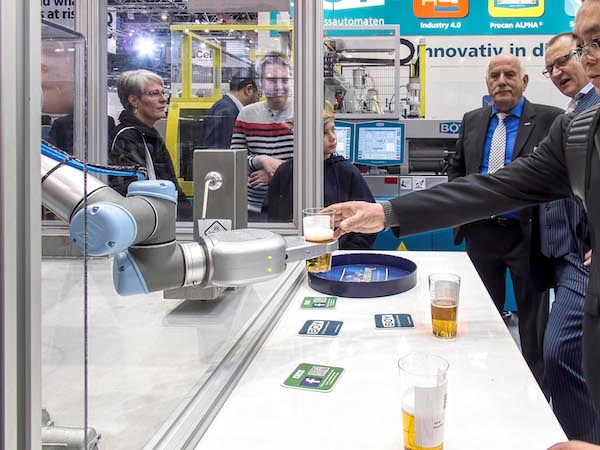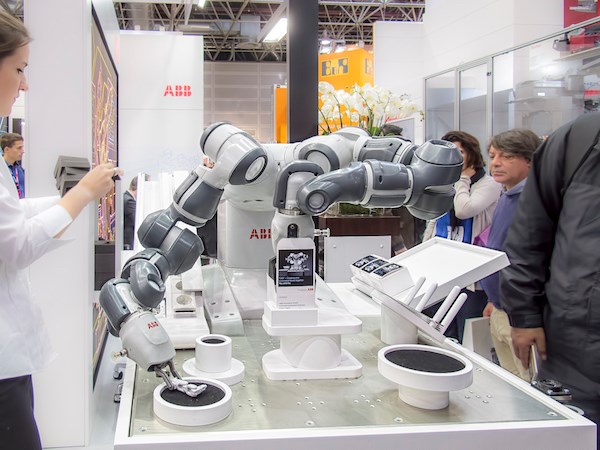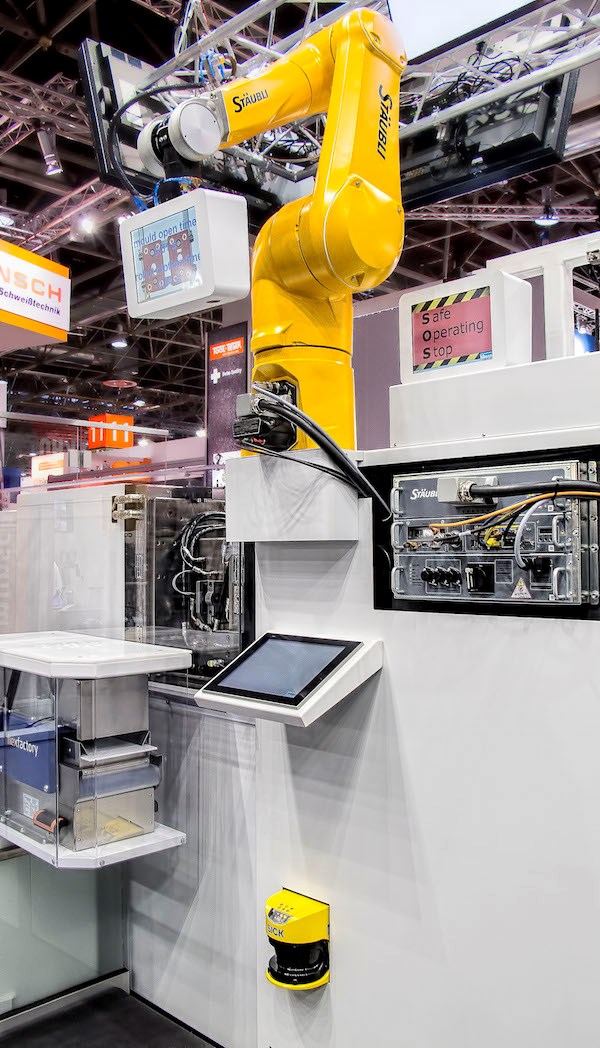Now That’s “Collaborative”!
Pick-and-place product handling … simple assembly tasks … sure, or why not serving a cold beer?
Pick-and-place product handling … simple assembly tasks … sure, or why not serving a cold beer?
So-called “collaborative” robots, or “cobots,” are gaining interest and adherents among plastics molders, who welcome the idea of robots working safely side by side with humans, unrestricted by “hard” guarding.
They also entertained and refreshed visitors to October’s K 2016 show in Dusseldorf. Among several examples at the show, Universal Robots USA, Inc. (E. Setauket, N.Y.) put one of its six-axis cobots to work at the Boy Machines Inc. exhibit, handing out freshly molded drink cups digitally printed with the recipient’s name and, on request, filled with beer. Direct transfer of the cup from the robot’s gripper to a visitor’s hand was a vivid illustration of safe collaboration.

Among new cobots on display was the two-armed, tabletop assembly model, dubbed YuMi (pictured), which is the first cobot from ABB Automation (ABB Inc. Robotics Auburn Hills, Mich.). Fanuc Automation (FANUC America Corp., Rochester Hills, Mich.) also showed off one of its new “CR” six-axis robots. The accompanying photo shows how human contact safety interrupts its operation.

And In addition, Kuka Robotics Corporation (Shelby Township, Mich.) showed off its seven-axis cobots, designated LBR (lightweight robot) IIWA (Intelligent Industrial Work Assistant), first seen at Fakuma 2015.
In addition, suppliers showed how to make conventional robots more “collaborative”—focusing on allowing technicians access to robots without shutting them down altogether. Both Sytrama USA, sister company of Negri Bossi North America (New Castle, Del.), and Staubli Robotics (Staubli Corporation, Duncan, S.C.) demonstrated robots that use compact laser scanners to sense the presence of humans.
When a technician approaches within a certain distance, the robot continues its cycle, but at a much reduced speed, which Staubli calls Safe Limited Speed (SLS). Coming even closer can cause the robot to slow further and finally stop completely (Safe Operating Stop, or SOS). It starts up again instantly when the person moves away a certain distance. Staubli’s new generation of TX2 six-axis robots (pictured) use the same principle to define a Safe Zone around the end-of-arm tooling to prevent collisions with inanimate obstacles. These models also have a sensory skin, which when touched immediately brings the robot to a halt.

Sources at both Sytrama and Staubli agree that even with the laser scanner, some sort of physical barrier is still necessary to prevent accidental encroachments from hindering robot operations, but full-height guarding may no longer be needed with this safety feature. One maker of the laser scanners is Sick AG in Germany (U.S. office in Minneapolis). It is the yellow object at the bottom of the photo with the Staubli robot.

Related Content
-
Automation in Thermoforming on the Rise
Equipment suppliers’ latest innovations exemplify this trend driven by factors such as labor shortages, higher-speed thermoformers and tighter quality control.
-
Drones and Injection Molding Ready for Takeoff
Drones and unmanned aerial vehicles (UAV) are approaching an inflection point where their production volumes — and functionality — will increasingly point to injection molding.
-
How Was K 2022 for Blow Molding?
Over a dozen companies emphasized sustainability with use of foam and recycle, lightweighting and energy savings, along with new capabilities in controls, automation and quick changeovers.














.png;maxWidth=300;quality=90)

